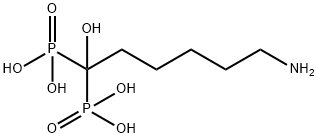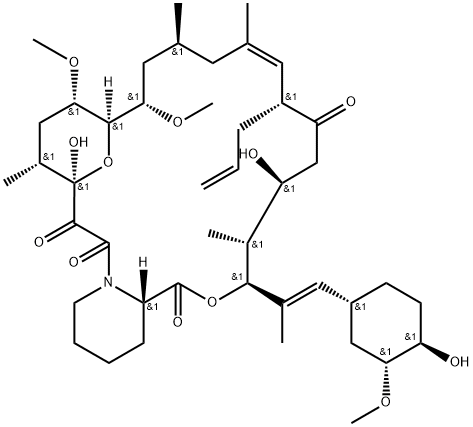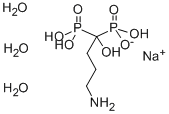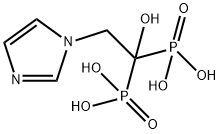NERIDRONATE SODIUM HYDRATE
Synonym(s):6-Amino-1-hydroxyhexylidene bisphosphonic acid;Neridronic acid;Nerixia
- CAS NO.:79778-41-9
- Empirical Formula: C6H17NO7P2
- Molecular Weight: 277.15
- MDL number: MFCD08060095
- EINECS: 200-258-5
- SAFETY DATA SHEET (SDS)
- Update Date: 2023-06-08 09:03:01

What is NERIDRONATE SODIUM HYDRATE?
Description
Neridronic acid was launched in Italy as intravenous or intramuscular injection for the treatment of osteogenesis imperfecta. It is the first drug launched worldwide for this “orphan disease” characterized by a fragility of the bone. Sufferers risk frequent fractures commencing during infancy, eventually leading to bone deformation and a severe deterioration of the quality of life and life expectancy. Neridronic acid is structurally related to the second generation of bisphosphonates characterized by an amino terminal group and can be synthesized by treating E-aminocaproic acid with phosphoric acid and phosphorous trichloride. Bisphosphonates, synthetic analogs of the endogenous mineral deposition inhibitor pyrophosphate, are extremely potent inhibitors of bone resorption and increase bone mineral density, possibly by inhibiting the activity of osteoclasts and promoting the death of these bone-eroding cells. In vitro, neridronic acid was a poor inhibitor of phagocytosis, but significantly and dose dependently inhibited 8glucuronidase release and superoxide anion production in the rat peritoneal macrophage, two parameters that may have a part in bone resorption. In a clinical study on patients with osteogenesis imperfecta, neridronic acid increased remarkably bone mass in young growing individuals. In adults the changes were less important but still significant.
Description
Neridronic acid is an amino bisphosphonate that inhibits farnesyl pyrophosphate (FPP) synthase (IC50 = 388.2 nM in a cell-free assay). It decreases the differentiation of RAW 264.7 cells into osteoclasts in a CRL-12257 co-culture model of osteoclastogenesis when used at concentrations ranging from 0.001 to 100 μM. Neridronic acid (30 μM) inhibits FGF2-induced proliferation and tube formation in human umbilical vein endothelial cells (HUVECs). It reduces the loss of trabeculae and increases bone density in the tibial metaphysis of growing rats when administered subcutaneously at a dose of 0.1 mg/kg per day.
Originator
lnstituto Gentili (Italy)
Definition
ChEBI: Neridronic acid is a 1,1-bis(phosphonic acid).
brand name
Nerixia
Biochem/physiol Actions
Neridronate is a bone resorption inhibitor. It is used to treat Osteogenesis Imperfecta, an "orphan disease" characterized by a fragility of the bone enough to be named the "illness of bones of crystal".
Synthesis
6- Aminohexanoic acid (152) was reacted with phosphorus trichloride and phosphorous acid at 85??C, and then water was added to generate free diphosphonic acid 16 in 78% overall yield [59].

Properties of NERIDRONATE SODIUM HYDRATE
| Melting point: | 245° |
| Boiling point: | 600.1±65.0 °C(Predicted) |
| Density | 1.658±0.06 g/cm3(Predicted) |
| storage temp. | 2-8°C |
| solubility | H2O: 8 mg/mL, soluble |
| form | solid |
| pka | 1.93±0.10(Predicted) |
| color | white |
Safety information for NERIDRONATE SODIUM HYDRATE
| Signal word | Warning |
| Pictogram(s) |
 Exclamation Mark Irritant GHS07 |
| GHS Hazard Statements |
H302:Acute toxicity,oral |
| Precautionary Statement Codes |
P280:Wear protective gloves/protective clothing/eye protection/face protection. P305+P351+P338:IF IN EYES: Rinse cautiously with water for several minutes. Remove contact lenses, if present and easy to do. Continuerinsing. |
Computed Descriptors for NERIDRONATE SODIUM HYDRATE
New Products
Tert-butyl bis(2-chloroethyl)carbamate (S)-3-Aminobutanenitrile hydrochloride N-Boc-D-alaninol N-BOC-D/L-ALANINOL 3-(2,4-Dimethoxybenzyl)dihydropyrimidine-2,4(1H,3H)-dione 7-Bromo-1H-indazole N-octanoyl benzotriazole 3,4-Dibenzyloxybenzaldehyde 4-Hydrazinobenzoic acid Electrolytic Iron Powder Fmoc-Val-Cit-PAB 1,1’-CARBONYLDIIMIDAZOLE R-2-BENZYLOXY PROPIONIC ACID 4-HYDROXY BENZYL ALCOHOL 1,1’-CARBONYLDI (1,2-4 TRIAZOLE) S-2-CHLORO PROPIONIC ACID (2-Hydroxyphenyl)acetonitrile 4-Bromopyrazole 5-BROMO-2CYANO PYRIDINE 5,6-Dimethoxyindanone 5-broMo-2-chloro-N-cyclopentylpyriMidin-4-aMine 1-(4-Methylphenylsulfonyl)-1H-1,2,3-benzotriazole 1-(2-Chlorobenzyl)-4-nitro-1H-pyrazole 1-(2-Nitrophenyl)-4-phenylpiperazineRelated products of tetrahydrofuran






You may like
-
 Neridronate 95% CAS 79778-41-9View Details
Neridronate 95% CAS 79778-41-9View Details
79778-41-9 -
 Neridronate CAS 79778-41-9View Details
Neridronate CAS 79778-41-9View Details
79778-41-9 -
 Ste-Glu-AEEA-AEEA-OSUView Details
Ste-Glu-AEEA-AEEA-OSUView Details
1169630-40-3 -
 1446013-08-6 Fmoc-His-Aib-OH TFA 98%View Details
1446013-08-6 Fmoc-His-Aib-OH TFA 98%View Details
1446013-08-6 -
 127464-43-1 99%View Details
127464-43-1 99%View Details
127464-43-1 -
 Chloro Uracil 99%View Details
Chloro Uracil 99%View Details
1820-81-1 -
 2-ETHYLPYRIDINE 100-71-0 99%View Details
2-ETHYLPYRIDINE 100-71-0 99%View Details
100-71-0 -
 13162-05-5 99%View Details
13162-05-5 99%View Details
13162-05-5